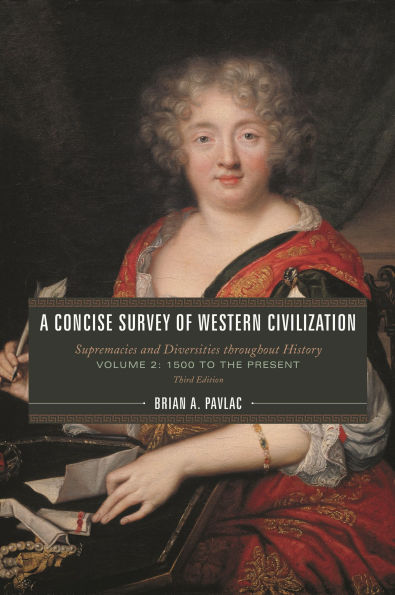This engaging text offers a concise, readable description of our common Western heritage. Providing a tightly focused narrative and interpretive structure, Brian Pavlac covers the basic historical information that all educated adults should know. His joined terms “supremacies and diversities” develop major themes of conflict and creativity throughout history. “Supremacies” centers on the use of power to dominate societies, ranging from warfare to ideologies. Supremacy, Pavlac shows, seeks stability, order, and incorporation. “Diversities” encompasses the creative impulse that produces new ideas, as well as efforts of groups of people to define themselves as “different.” Diversity creates change, opportunity, and individuality.
These concepts of historical tension and change, whether applied to political, economic, technological, social, or cultural trends, offer a cohesive explanatory organization. The text is also informed by five other topical themes: technological innovation, migration and conquest, political and economic decision-making, church and state, and disputes about the meaning of life. The third edition has added new primary source projects, improved maps and illustrations to enhance the visual dimension,
Written with flair, this easily accessible yet deeply knowledgeable text provides all the essentials for a course on Western civilization. Conceived as a seamless, affordable overview, not artificially boiled down from a lengthier text, it can be used as a standalone for a one-term course or combined with Volume 1 for two-term course.
This engaging text offers a concise, readable description of our common Western heritage. Providing a tightly focused narrative and interpretive structure, Brian Pavlac covers the basic historical information that all educated adults should know. His joined terms “supremacies and diversities” develop major themes of conflict and creativity throughout history. “Supremacies” centers on the use of power to dominate societies, ranging from warfare to ideologies. Supremacy, Pavlac shows, seeks stability, order, and incorporation. “Diversities” encompasses the creative impulse that produces new ideas, as well as efforts of groups of people to define themselves as “different.” Diversity creates change, opportunity, and individuality.
These concepts of historical tension and change, whether applied to political, economic, technological, social, or cultural trends, offer a cohesive explanatory organization. The text is also informed by five other topical themes: technological innovation, migration and conquest, political and economic decision-making, church and state, and disputes about the meaning of life. The third edition has added new primary source projects, improved maps and illustrations to enhance the visual dimension,
Written with flair, this easily accessible yet deeply knowledgeable text provides all the essentials for a course on Western civilization. Conceived as a seamless, affordable overview, not artificially boiled down from a lengthier text, it can be used as a standalone for a one-term course or combined with Volume 1 for two-term course.

A Concise Survey of Western Civilization: Supremacies and Diversities throughout History
390
A Concise Survey of Western Civilization: Supremacies and Diversities throughout History
390Hardcover(Third Edition)

Product Details
| ISBN-13: | 9781538112557 |
|---|---|
| Publisher: | Bloomsbury Academic |
| Publication date: | 01/22/2019 |
| Edition description: | Third Edition |
| Pages: | 390 |
| Product dimensions: | 7.30(w) x 10.05(h) x 1.05(d) |
| Age Range: | 18 Years |
